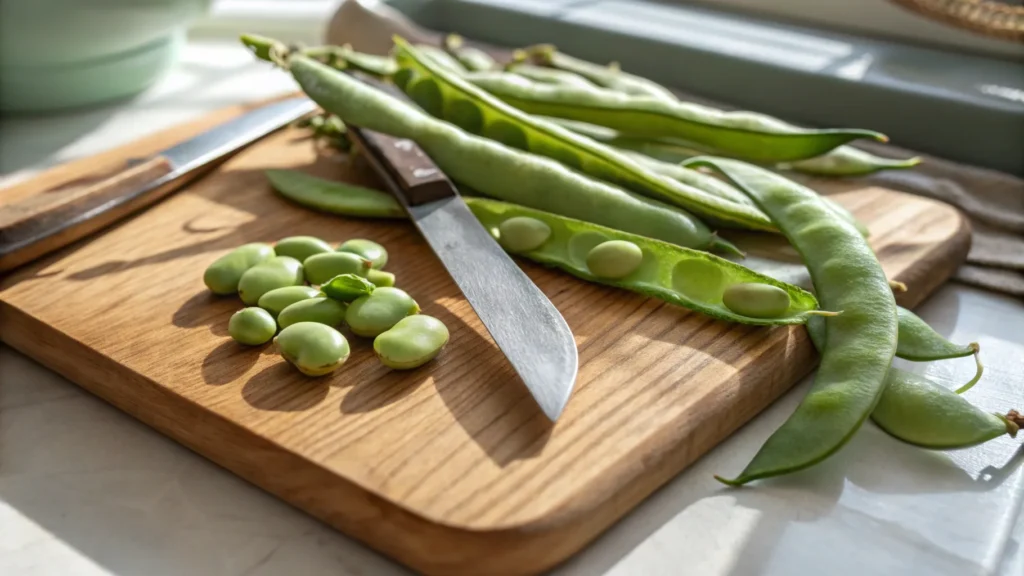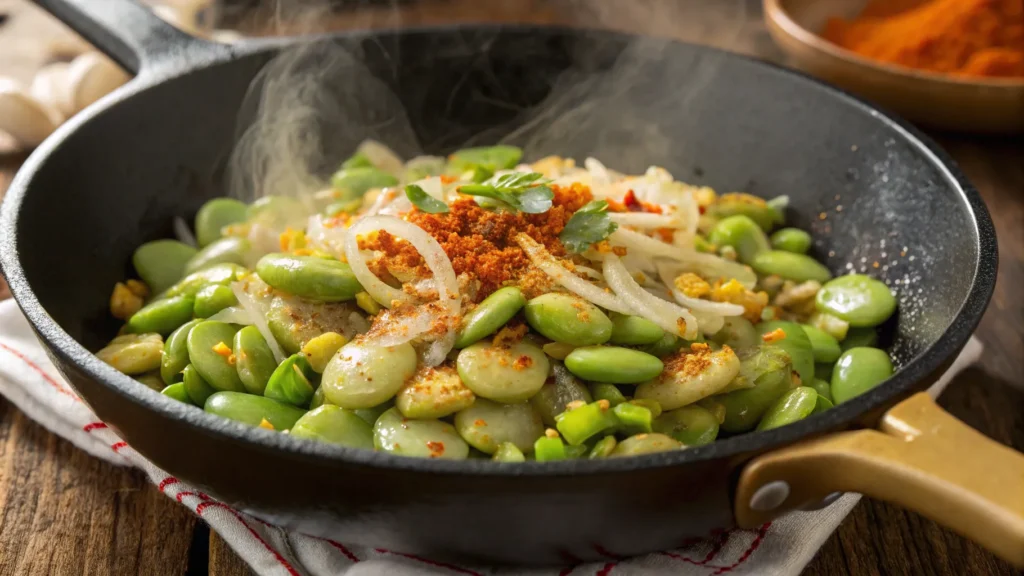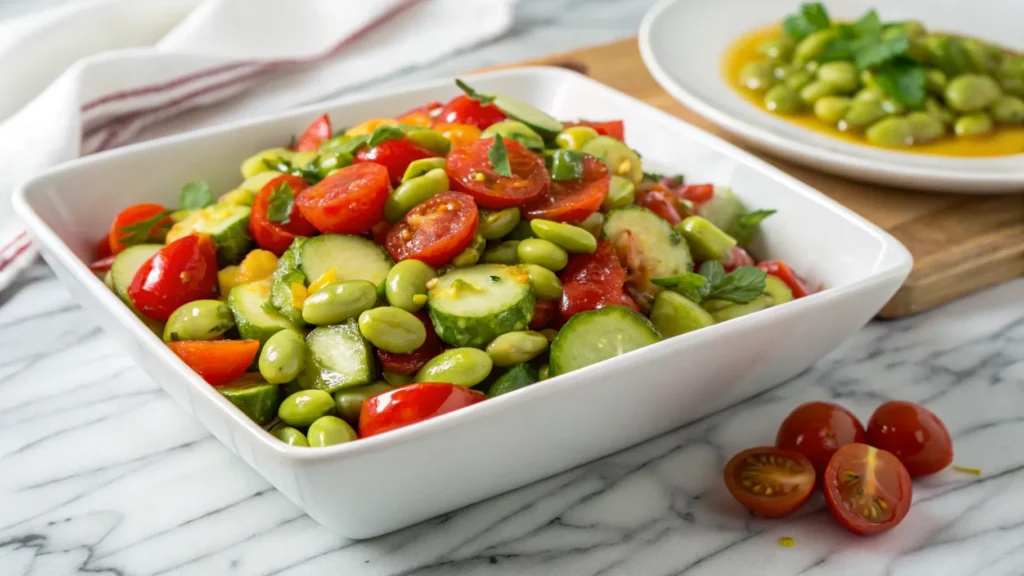Lima beans, also known as butter beans, are a versatile and nutritious ingredient that has earned a place in kitchens around the world. Packed with essential nutrients like protein, fiber, and iron, these beans are an excellent addition to a healthy diet. Whether you’re exploring plant-based eating, looking for new ways to incorporate legumes into your meals, or simply seeking to add variety to your menu, lima beans can become your next favorite ingredient.
But here’s the catch: preparing lima beans the right way can make all the difference. From creamy soups to hearty salads and stir-fries, these beans can be used in countless recipes that are not only delicious but also super easy to make.
In this article, we’ll explore everything you need to know about lima beans, from their nutritional benefits and taste to the best ways to cook and enjoy them. We’ll also answer some of the most common questions people have about these delightful legumes, ensuring you walk away as a lima bean expert. Ready to discover the best way to eat lima beans? Let’s dive in!
Table of Contents
What Are Lima Beans?

Nutritional Profile of Lima Beans
Lima beans are a nutritional powerhouse. These legumes are low in fat but rich in protein, making them an excellent choice for vegetarians and vegans. They also contain high levels of dietary fiber, which supports digestion and promotes gut health. In addition, lima beans are packed with essential vitamins and minerals, such as:
- Iron: Helps prevent anemia and supports overall energy levels.
- Magnesium: Promotes strong bones and heart health.
- Potassium: Helps regulate blood pressure and supports muscle function.
- Vitamin B6: Assists in brain function and mood regulation.
For anyone seeking a nutrient-dense food that’s both filling and versatile, lima beans tick all the boxes.
History and Popularity of Lima Beans Worldwide
Lima beans, named after the capital city of Peru, have been cultivated for over 7,000 years. They originated in Central and South America and quickly became a dietary staple due to their easy cultivation and long shelf life when dried.
Today, lima beans are enjoyed in cuisines across the globe. In the southern United States, for instance, they are a key ingredient in dishes like succotash—a hearty blend of lima beans and corn. In India, lima beans are used in flavorful curries, while Mediterranean countries often feature them in salads or stews.
Whether fresh, frozen, or dried, lima beans have earned their reputation as a global favorite, thanks to their adaptability and ability to complement a variety of flavors.
Why Do People Eat Lima Beans?
Health Benefits of Lima Beans
Lima beans aren’t just delicious—they’re also incredibly healthy. Here are some of the key health benefits that make people include them in their diets:
- Rich in Protein: Lima beans are an excellent source of plant-based protein, supporting muscle growth and repair, especially for vegetarians and vegans.
- Supports Heart Health: Their high fiber content helps lower cholesterol levels, reducing the risk of heart disease. Additionally, potassium in lima beans aids in maintaining healthy blood pressure.
- Promotes Digestive Health: With a significant amount of dietary fiber, lima beans support a healthy digestive system by preventing constipation and promoting regularity.
- Boosts Energy Levels: Thanks to their iron content, lima beans combat fatigue by aiding in the production of red blood cells.
- Regulates Blood Sugar: Lima beans have a low glycemic index, making them ideal for people with diabetes or those seeking to stabilize blood sugar levels.
By incorporating lima beans into your meals, you can enjoy these health benefits while adding variety and flavor to your diet.
Common Uses in Diets Around the World
Lima beans are a staple in many traditional diets due to their versatility. Some popular ways they’re used include:
- In Soups and Stews: Their creamy texture adds richness to dishes like chowders or hearty vegetable soups.
- As a Side Dish: Often sautéed with onions, garlic, and herbs, lima beans are a flavorful side for any meal.
- In Salads: Their firm texture makes them a great addition to cold salads, paired with ingredients like tomatoes, cucumbers, and vinaigrettes.
- As a Meat Substitute: Mashed or whole, lima beans are often used in vegetarian patties and fillings for a protein boost.
From health benefits to culinary uses, it’s no wonder why lima beans are a favorite for so many people.
What Is the Best Way to Eat Lima Beans?

Best Cooking Methods for Lima Beans
Preparing lima beans properly is key to enjoying their creamy texture and mild flavor. Here are some of the best cooking methods:
- Boiling:
- Perfect for fresh or dried lima beans, boiling ensures they’re tender and ready for use in various recipes.
- To boil dried lima beans, soak them overnight to reduce cooking time. Then, simmer in water for about 45-60 minutes until soft.
- Steaming:
- Steaming preserves the nutrients in lima beans and enhances their natural flavor.
- Fresh lima beans can be steamed in a basket for 15-20 minutes.
- Sautéing:
- Sautéing lima beans with garlic, onions, and your favorite spices can create a delicious side dish in minutes.
- Use olive oil or butter for added richness and a golden finish.
- Roasting:
- Roasting lima beans gives them a slightly crispy texture. Simply toss cooked beans in olive oil, season with spices, and roast at 400°F (200°C) for 20 minutes.
- Blending into Soups or Purees:
- Blending lima beans into soups adds creaminess without the need for dairy. They’re also great pureed into dips or spreads.
Popular Recipes Using Lima Beans
- Lima Bean and Veggie Stir-Fry:
- Combine cooked lima beans with fresh vegetables like bell peppers, zucchini, and broccoli. Toss with soy sauce and sesame oil for a quick and healthy dinner.
- Succotash:
- A southern classic, succotash combines lima beans with corn, tomatoes, and butter for a flavorful and colorful side dish.
- Lima Bean Hummus:
- Swap chickpeas for lima beans in this twist on a classic hummus recipe. Blend cooked lima beans with tahini, garlic, lemon juice, and olive oil for a creamy, protein-packed dip.
- Lima Bean Soup:
- Pair lima beans with root vegetables like carrots and potatoes in a hearty, comforting soup.
- Lima Bean Salad:
- Toss cooked lima beans with cherry tomatoes, red onions, feta cheese, and a lemon vinaigrette for a refreshing, protein-rich salad.
Exploring different cooking methods and recipes can make lima beans a delicious and versatile addition to your meals!
Do Lima Beans Need to Be Cooked? (350 words)
Raw vs Cooked Lima Beans: A Safety Perspective
Lima beans should always be cooked before eating, as eating them raw can be unsafe. Raw lima beans contain a compound called linamarin, which can release cyanide when consumed. While the amount is small, it can still pose a risk if eaten in significant quantities. Cooking lima beans thoroughly breaks down linamarin, rendering them completely safe to eat.
For dried lima beans, soaking them overnight not only reduces cooking time but also helps to eliminate some of the natural compounds that can cause digestive discomfort. When cooking, ensure the beans are soft and tender, which is a sign that they’re safe to eat.
Tips for Preparing and Cooking Lima Beans Safely
Follow these steps to prepare and cook lima beans for maximum safety and taste:
- Soak Dried Lima Beans:
- Rinse the beans under cold water to remove any debris.
- Soak them in water for at least 8 hours or overnight. This softens the beans and ensures even cooking.
- Discard the Soaking Water:
- Always drain and rinse soaked beans before cooking to remove any remaining compounds.
- Cook Thoroughly:
- Boil the beans in fresh water for at least 45–60 minutes for dried beans, or until they are soft and fully cooked.
- Fresh or frozen lima beans typically cook faster, in 15–20 minutes.
- Avoid Undercooking:
- Even slightly undercooked lima beans can cause stomach upset. Ensure they’re fully tender before serving.
- Season After Cooking:
- Adding salt or acidic ingredients like tomatoes during cooking can make beans tough, so season them after they’re cooked.
By following these tips, you can enjoy lima beans safely while taking advantage of their rich flavor and nutritional benefits.
What Do Lima Beans Taste Like?
Describing the Flavor and Texture
Lima beans have a mild, buttery flavor that makes them incredibly versatile in cooking. When cooked properly, they have a creamy texture that melts in your mouth. This unique combination of subtle taste and soft consistency has earned lima beans the nickname “butter beans.”
The taste can vary slightly depending on how they’re prepared:
- Boiled Lima Beans: These have a clean, earthy flavor with a smooth finish, making them perfect for soups and stews.
- Sautéed Lima Beans: When cooked with garlic, olive oil, or spices, their flavor becomes richer and more robust.
- Roasted Lima Beans: Roasting enhances their natural sweetness and adds a nutty undertone.
Their neutral flavor profile makes lima beans a great ingredient to pair with bold spices, sauces, and herbs, as they absorb surrounding flavors beautifully.
Pairing Lima Beans with Other Ingredients
Lima beans work well with a variety of ingredients, both simple and complex. Here are some common pairings:
- Vegetables: Corn, tomatoes, bell peppers, onions, and zucchini complement their texture and flavor.
- Herbs and Spices: Thyme, parsley, paprika, garlic, and cumin elevate their taste.
- Protein Sources: Pair them with chicken, shrimp, or tofu for a hearty and balanced meal.
- Grains: Add lima beans to rice, quinoa, or couscous for a complete dish.
Whether you’re cooking a simple side or a complex main course, lima beans adapt beautifully, making them an easy favorite for any meal.
Tips to Make Lima Beans More Delicious
Spices and Herbs to Elevate the Flavor
Lima beans are a blank canvas, and with the right seasonings, they can transform into a flavorful masterpiece. Here are some ideas to make your lima beans taste amazing:
- Garlic and Onion: Sautéing lima beans with minced garlic and onions adds depth and aroma.
- Herbs: Fresh herbs like thyme, parsley, dill, or cilantro give lima beans a fresh and fragrant flavor.
- Spices: Try cumin, smoked paprika, curry powder, or even a hint of chili flakes for a spicy kick.
- Citrus Zest: Add a dash of lemon or lime zest to brighten the flavor and balance the creaminess of the beans.
Don’t forget to experiment with blends like Italian seasoning, Cajun spice, or garam masala for a global twist.
Combining Lima Beans with Other Foods
Lima beans shine when paired with complementary ingredients. Here are a few winning combinations:
- Lima Beans and Bacon: Sauté lima beans with crispy bacon bits for a smoky and savory dish.
- Lima Beans and Corn: Combine lima beans with sweet corn for a Southern-inspired succotash.
- Lima Beans in Pasta: Toss lima beans into pasta with olive oil, garlic, and Parmesan cheese for a quick and satisfying meal.
- Lima Beans in Soups and Stews: Their creamy texture makes them perfect for thickening soups like chowders or hearty stews.
Cooking Hacks for Maximum Flavor
- Use Stock Instead of Water: Cook lima beans in chicken or vegetable stock to infuse them with rich flavor.
- Add Fat: Butter, olive oil, or coconut milk enhances their creamy texture and adds richness.
- Roast for Crunch: Roasting cooked lima beans with olive oil and spices creates a crunchy snack that’s both healthy and addictive.
By using these tips and combinations, you can elevate your lima beans into a standout dish that pleases even the pickiest eaters.
Quick and Easy Lima Bean Recipes

1. Lima Bean Salad Recipe
This vibrant and refreshing salad is perfect for a quick lunch or side dish.
Ingredients:
- 2 cups cooked lima beans
- 1 cup cherry tomatoes (halved)
- 1 cucumber (diced)
- 1/4 cup red onion (finely chopped)
- 2 tbsp olive oil
- 1 tbsp lemon juice
- Salt and pepper to taste
- Fresh parsley (chopped)
Instructions:
- In a large bowl, combine lima beans, cherry tomatoes, cucumber, and red onion.
- Drizzle olive oil and lemon juice over the mixture.
- Season with salt and pepper, then toss everything until well combined.
- Garnish with fresh parsley and serve chilled.
2. Sautéed Garlic Lima Beans Recipe
This quick recipe is packed with flavor and works as a side dish or a light main course.
Ingredients:
- 2 cups cooked lima beans
- 2 tbsp olive oil
- 3 garlic cloves (minced)
- 1/2 tsp smoked paprika
- 1 tbsp lemon juice
- Salt and pepper to taste
Instructions:
- Heat olive oil in a skillet over medium heat.
- Add minced garlic and sauté until fragrant (about 1 minute).
- Toss in the lima beans and stir to coat them in the garlic oil.
- Sprinkle with smoked paprika, then season with salt and pepper.
- Cook for 5–7 minutes, stirring occasionally, until the beans are slightly golden.
- Finish with a splash of lemon juice before serving.
3. Creamy Lima Bean Soup Recipe
This comforting soup is rich, hearty, and easy to prepare.
Ingredients:
- 2 cups cooked lima beans
- 1 small onion (chopped)
- 2 garlic cloves (minced)
- 2 cups vegetable stock
- 1/2 cup heavy cream (or coconut milk for a vegan option)
- 1 tbsp olive oil
- Salt, pepper, and thyme to taste
Instructions:
- Heat olive oil in a pot over medium heat. Add onion and garlic, cooking until softened.
- Stir in the lima beans and cook for 2–3 minutes.
- Pour in the vegetable stock, bring to a boil, and let simmer for 10 minutes.
- Use an immersion blender to puree the soup until smooth.
- Stir in the heavy cream, season with salt, pepper, and thyme, and serve warm.
FAQs:
What is the best way to eat lima beans?
The best way to eat lima beans depends on your personal taste preferences, but popular methods include boiling, sautéing, roasting, or incorporating them into dishes like soups, stews, and salads. For a quick and delicious option, try sautéed garlic lima beans or a simple lima bean salad with fresh vegetables and herbs. If you’re feeling adventurous, you can even mash lima beans into hummus or add them to pasta dishes.
Why do people eat lima beans?
People eat lima beans because they are nutritious, versatile, and delicious. Packed with protein, fiber, and essential nutrients like magnesium and iron, they offer numerous health benefits, including improved digestion, heart health, and sustained energy. Their creamy texture and mild flavor make them a favorite in a variety of recipes, from side dishes to hearty main courses.
Do lima beans need to be cooked?
Yes, lima beans need to be cooked before eating. Raw lima beans contain linamarin, a compound that can release small amounts of cyanide if consumed uncooked. Cooking breaks down this compound, making the beans safe to eat. Whether you’re using fresh, frozen, or dried lima beans, ensure they’re fully cooked before serving.
What do lima beans taste like?
Lima beans have a mild, buttery flavor with a creamy texture. Their subtle taste allows them to pair well with a variety of ingredients, such as garlic, herbs, and spices. Depending on how they’re prepared, lima beans can taste slightly nutty or earthy, making them an excellent base for savory dishes.
Conclusion
Lima beans are a truly versatile and nutritious addition to any diet. Their mild, buttery flavor and creamy texture make them a perfect base for a wide range of dishes, from simple salads to hearty soups and stews. Packed with essential nutrients like protein, fiber, iron, and potassium, they offer numerous health benefits, including improved heart health, better digestion, and sustained energy levels.
Whether you prefer them sautéed with garlic, tossed into a salad, or blended into a creamy soup, the possibilities are endless. Cooking lima beans correctly is essential—not only to enhance their flavor but also to ensure they’re safe to eat. With a bit of creativity and some simple tips, you can turn lima beans into a flavorful and satisfying part of your meals.
If you haven’t yet explored the versatility of lima beans, now is the time! They’re not just a healthy choice; they’re also a delicious one. So grab a bag of dried, fresh, or frozen lima beans and start experimenting in the kitchen. Your taste buds and body will thank you!
Lima Beans Recipe: Easy Southern-Style Cooking and Creative Variations
Facebook Eminent Recipes

